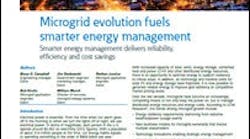Microgrid Evolution Fuels Smarter Energy Management
Smarter energy management delivers reliability, efficiency and cost savings. From the time when our alarm goes off in the morning to when we turn the lights off at night, we use electrical power. In terms of magnitude, each person in the U.S. spends around $3,052 on electricity (2012 figures). With a population of about 314 million people at the time, our energy habits equate to spending something in the order of $958 billion per year.
Our homes, businesses, healthcare, community infrastructure and educational institutions all rely on power. Yet, due to an aging infrastructure and increasing demand, our electrical grid is not as reliable or resilient as we need. In the face of major storms, grid outages, grid instabilities, cyber threats and other events, we need to be smarter and more cost-efficient about how we generate, manage, distribute and strengthen our power grids.
With increased capacity of solar, wind, energy storage, combined heat and power (CHP) and other distributed energy resources, there is an opportunity to optimize energy to support resiliency to critical areas. In addition, as technology and material costs for solar PV and energy storage have improved, it is now possible to generate reliable energy to improve grid resiliency at competitive market pricing levels.
Over the last decade, microgrids have become an increasingly compelling means to not only keep the power on, but to manage distributed energy resources and energy costs. According to GTM Research, the trends driving microgrid growth include:
• Energy resiliency requirements stemming from extreme weather/power outage events
• New business models for microgrid ownership that involve multiple stakeholders
• Technology innovations enabling strategic energy management
• Opportunity for microgrids that support commercial and industrial customers
Download this white paper and learn how a microgrid can help your organization build a smarter energy management strategy.
